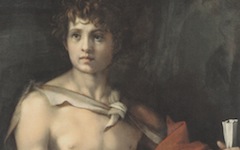Andrea Del Sarto’s Madonna in Gloria (1530)

Andrea del Sarto, Madonna in Gloria (1530) Oil on canvas. Palazzo Pitti, Florence.
Click image to enlarge.
This painting by Andrea del Sarto in the Palazzo Pitti hangs in the same room as his St. John the Baptist (c.1523) which already has its own entry on EPPH. This one depicts the Virgin Mary ascending into heaven and was painted in the last year of Del Sarto's life, touched up by his assistants after his death. Nevertless, it is his composition, largely painted by the master.
Click next thumbnail to continue
Just as the other painting includes Andrea's initial so this one has an A in a saint's hands and forearm resting on a sword (see diagram). The hilt suggests the cross-bar of the A. Thus this weapon, a common visual metaphor in art for a long, thin paintbrush, is combined with his hands (craft) and the sword's shape (a Cross) to suggest the divinity and Christology of the artist's craft. The fourth-century saint, San Fedele di Como, is recorded in contradictory accounts as both a soldier and archbishop of Milan. His figure in armor, though, conveys, as I have discussed before, the courage with which the artist must face his creative struggle.1 Art, for them, is a constant battle.
Click next thumbnail to continue
What is more, the A's apex is directly underneath the ascending Virgin. A line runs up through the Virgin's womb and between her eyes (left). Divinity is one essence and Andrea identifies both with Christ's passion (the artist's creative and spiritual struggle) and the Virgin's Immaculate Conception, a common but virtually unknown pun referring to the artist's own Immaculate Conception, the image we see. The line from the saint's hands (craft) to the Virgin's eyes (perception) unites art's two most important symbols. The artist's mind is also androgynous, in other words fully human. That is why Andrea is both male soldier and Virgin. It is only our perception of reality that causes us to think in a gendered way. Spiritually pure minds theoretically do not.
Click next thumbnail to continue
There is a lot more to see in this painting as in most works discussed on EPPH, but do notice the pose of St. Catherine of Alexandria, turning to look out over her shoulder like an artist checking her model. Her figure does not seem to share the same space with the others thus suggesting she is outside the canvas "painting" it.

L: Del Sarto, Madonna in Gloria (1530) Palazzo Pitti, Florence.
R: Del Sarto, St. John the Baptist (c.1523) Palazzo Pitti, Florence.
Click image to enlarge.
So, two paintings by Andrea both in the same room contain an A prominently positioned to convey a meaning that is rarely imagined and only ever seen, as far as I know, by artists. Sadly, they say that there is no land left on earth unexplored; in art, luckily, there's a whole continent. Go out there and see what you can find.
More Works by Del Sarto
Notes:
1. Giorgione, Lucas Cranach the Elder, Rembrandt, Bernini, Louis Corinth, just to name a few, all painted their self-portraits in armor.
Original Publication Date on EPPH: 08 Oct 2013. © Simon Abrahams. Articles on this site are the copyright of Simon Abrahams. To use copyrighted material in print or other media for purposes beyond 'fair use', you must obtain permission from the copyright owner. Websites may link to this page without permission (please do) but may not reproduce the material on their own site without crediting Simon Abrahams and EPPH.




